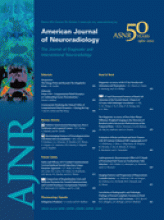The article “The Effect of Age and Cerebral Ischemia on Diffusion-Weighted Proton MR Spectroscopy of the Human Brain”1 in this issue of AJNR showcases an MR imaging technique that is unusual (at least in my opinion) as compared with those that are commonly clinically employed: diffusion-weighted MR spectroscopy (DW-MRS).2⇓⇓–5 Arguably well-summarized in the abstract of a review by Nicolay and colleagues in NMR in Biomedicine in 2001, this research tool allows one to “noninvasively quantitate the translational displacement of endogenous metabolites in intact mammalian tissues.”4
We would seem to be in an era of increased emphasis on quantification, and this technique may eventually lend itself nicely to that paradigm. DW-MR imaging has been studied in nervous system and musculoskeletal tissues,4 and in normal and disease states, including ischemia and neoplasia.4 Some of the metabolites studied include glucose and lactate.3 In the current article,1 Zheng and colleagues apparently sought to establish any effects of aging on baseline measures and then to also evaluate ischemia effects, if any. Establishing “normal” or “expected” variations would seem to be a noble goal to help put quantitative measurements taken from patients with disease states into perspective. The prospect of being able to examine intra- and extracellular metabolites in a quantitative fashion in vivo seems quite enticing to me, and I hope that this technology continues to mature within the research milieu and eventually start to help us in the applied, clinical environment.
Ten years later, the concept of being able to examine intra- and extracellular metabolites likely remains one of great import. When discussing the clinical applications of the plethora of advanced neuroimaging techniques available today with trainees, I like to focus on the combination of physiology examined with the perceived short-list differential diagnosis based on conventional neuroimaging. For example, PWI seems to me to be essentially based on the flux of blood (of course, this is a great simplification but it seems like a good place to start such a discussion). In a patient with a high-grade primary brain tumor, after surgery, after chemotherapy, after radiation therapy, and with a new intracranial mass lesion, what is the predominant component and/or interval change related to? Predominant tumor progression? Predominant treatment effect? Something else? In my experience, predominant tumor progression and predominant treatment effect are usually at the top of the short-list differential diagnosis. I like to then apply the logical question of which of the advanced neuroimaging techniques would theoretically “split” the top differential diagnostic considerations the most, thus making them easier to separate as diagnostic imaging considerations. Theoretically, a high-grade primary brain tumor would have an elevated flux of blood into the region and necrosis would have a decreased (or absent) flux of blood. Of course, things change over time and the advent of antiangiogenesis medications introduced a remarkable variation into the process of choosing and applying PWI in similar settings. I have long been impressed with the ability of DWI to contribute to the characterization of intracranial mass lesions on conventional neuroimaging. In particular, in my experience, DWI seems quite adept at the implication of densely cellular tumor. The routine clinical use of DWI, I think, helped us to effectively transition interpretation of cases such as these. To be sure, the last few years have seen these processes become both refined and more complicated—we now have situations such as true progression, pseudoprogression, true response, pseudoresponse, and so on. Daydreaming about DW-MRS and this article, I wonder if this could be another tool (in our metaphorical neuroimaging tool belt) for us in the ever-challenging, ever-changing arena of brain tumor imaging? Could this technique give us further insight into intracellular and extracellular metabolite diffusion and, if so, can that translate well to the applied clinical arena? Will we someday be deciding about whether or not to suggest a PET or a DW-MRS when confronted with a particularly challenging case? Or could DW-MRS become as commonplace as PWI or even DWI? Only time will tell. In the meantime, I can dream.
To finish this commentary, let us revisit the review article by Nicolay and colleagues for a closing summary thought: “In vivo diffusion-weighted MR spectroscopy…offers unprecedented opportunities for assessing the biophysical chemistry of intracellular metabolites, from which (ultra)structural details of the intracellular compartment can be noninvasively inferred.”4
- © 2012 by American Journal of Neuroradiology












